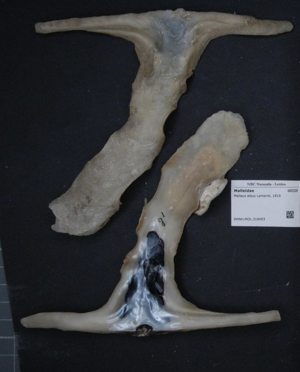White hammer clam
| White hammer clam | ||||||||||||
|---|---|---|---|---|---|---|---|---|---|---|---|---|

White hammer clam ( Malleus albus ) |
||||||||||||
| Systematics | ||||||||||||
|
||||||||||||
| Scientific name | ||||||||||||
| Malleus albus | ||||||||||||
| Lamarck , 1819 |
The White Hammer Shell ( Malleus albus ) is a shell - type from the family of hammer shells (Malleidae).
features
The very large, unevenly- hinged housing is greatly elongated in the dorsoventral direction. The anterior and posterior dorsal margins are also greatly elongated. The extensions are comparatively narrow and roughly the same length. As a result, the housing is hammer- or T-shaped in outline, with the “stem” standing perpendicular or slightly inclined to the dorsal edge (or lock edge). It is up to 24.5 cm long (or high, the "stem"), with a width of the dorsal edge ("head") of up to 25 cm. The edges of the flaps are wavy, but they fit together exactly. The cross section of the housing is flattened (“compressed”). There is only one sphincter muscle. The lock is without teeth. The ligament lies in a triangular ligament pit. The byssus slot is reduced in the adult housing. The muscle impressions also become indistinct.
The shell is aragonitic with a thick outer calcitic (prismatic layer) and extremely thick-shelled. It is dirty white, cream-colored or slightly yellowish in color, and the inside is cream-colored. Directly below the dorsal margin is a shell field consisting of mother-of-pearl . The ornamentation consists of strips parallel to the edge, which can be reinforced like ribs.
Similar species
The shells of the white hammer clam are somewhat more regular than the shells of the black hammer clam ( Malleus malleus ), and predominantly whitish compared to the black hammer clam, which are mostly dark to blackish in color.
Geographical distribution, habitat and way of life
The distribution area of the white hammer clam stretches from central Japan to northern Australia . In the Indian Ocean they are known from the Andamans and south-east India ( Andhra Pradesh ).
The animals are soft bottom dwellers in shallow water, which are anchored with the back and front appendages in the mud.
Taxonomy
The taxon was established in 1819 by Jean-Baptiste de Lamarck as the combination Malleus albus . Synonyms are: Malleus maculatus Donovan, 1823, Malleus normalis var. Albida Lamarck, 1819, Malleus novelesianus Iredale, 1931 Malleus savignyi Jousseaume in Lamy 1919.
supporting documents
literature
- S. Peter Dance, Rudo von Cosel (arrangement of the German edition): The great book of sea shells. 304 p., Verlag Eugen Ulmer, Stuttgart 1977, ISBN 3-8001-7000-0 (p. 230/31)
- Rudolf Kilias: Lexicon marine mussels and snails. 2nd edition, Verlag Eugen Ulmer, Stuttgart 1997, ISBN 3-8001-7332-8 (p. 182)
Individual evidence
- ↑ a b S. D. Gurumayum: The Malleidae (Mollusca: Bivalve) of India with a new distributional record of Malleus albus (Lamarck, 1819), from southeast cost of India-Nellore, Andhra Pradesh. Advances in Applied Science Research, 6 (8): 112-117, 2015 PDF
- ↑ Jean-Baptiste de Lamarck: Histoire naturelle des animaux sans vertèbres ... précédée d'une introduction offrant la détermination des caractères essentiels de l'animal, sa distinction du végétal et des autres corps naturels, enfin, l'exposition des principes fondamentaux de la zoologie. Self-published by the author, Paris 1815-1822. Online at www.biodiversitylibrary.org (p. 144)
- ^ MolluscaBase: Malleus albus Lamarck, 1819